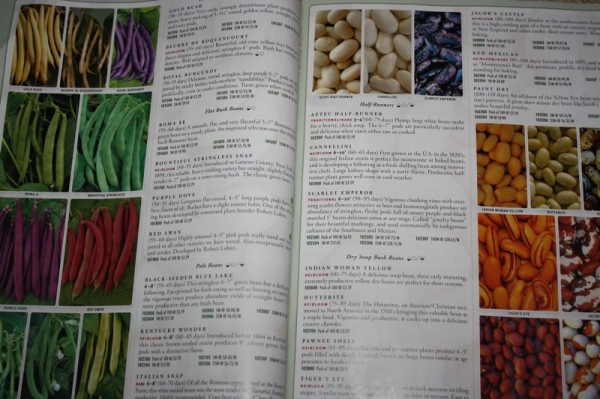Seed Cataloging
Oof, it’s been almost 2 weeks since I last posted. Ah well, you know how it goes, sometimes life just catches up with you. A new boss at work, some ongoing medical things I’m dealing with and a weekend away with the family, and boom – before you know it the time has disappeared.
Anyway, where was I? Oh yes, it’s seed catalog time!! Actually, it’s been seed catalog time for awhile, but given the fact that snow is still on the ground, there’s no reason why it can’t be ongoing.
Seed catalog time is that mysterious time after the ground has frozen, the earth (on this side of the world) is dark, and one dreams of spring.
Ok, as for me, I momentarily freaked out earlier this week when I realized we’re only 2 months away from pea-planting time. What happened to those dark, boring days of winter with nothing to do? Simply disappeared.
But the Seeds of Change catalog came a little while ago and I started perusing it soon after. Seeds of Change is a great little well known company that’s been helping to preserve biodiversity and promoting sustainable, organic agriculture since 1989. They offer so many organic seeds, including heirloom, traditional and rare (and some hybrid too).
The colors are what make me ooh and ahh over just about every veggie in this catalog. What vibrancy! I remember when the world had more color than white, black, drab gray and muddy brown.
And then K found the pages of heirloom apple trees, and his dream of an orchard all of a sudden seemed within reach. We know exactly where we would be planting these in our “dream home” (yes, we still can’t let it go and hope they’ll change their minds) and they would be bearing fruit in 2-4 years. At less than $50 a tree, I had no idea apple trees were so inexpensive (I thought they were hundreds of dollars per tree).
In our dreamland, these are the apple trees we would choose:
- Newtown Pippin
George Washington’s favorite apple. Yellow-green, firm, crisp flesh with a refreshing piney tartness. A self-fertile variety that also serves as a pollinator for other apple trees. Zones 4-10.
- Northern Spy
Large red and yellow skinned classic has crisp and juicy yellow flesh, and lively, subacid flavor. Great for pies or fresh eating. Ripens late and is an excellent keeper. Zones 4-9
- Roxbury Russet
Excellent old American cider apple, also good for eating fresh. Remarkable for its amount of sugar. Firm, slightly coarse, yellow-white flesh. Resistant to scab and cedar apple rust. Zones 5-9.
Man, a couple each of these, and we could be enjoying cider and apple pies, sauce, butter in a few short years. But for now, we keep dreaming.







